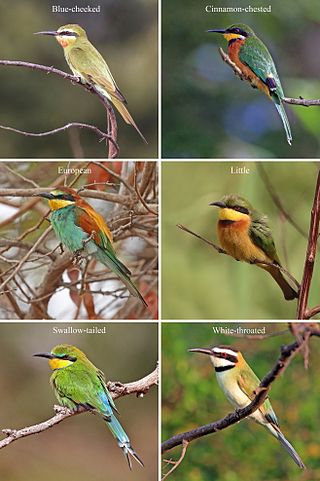
The bee-eaters are a group of birds in the family Meropidae, containing three genera and thirty species. Most species are found in Africa and Asia, with a few in southern Europe, Australia, and New Guinea. They are characterised by richly coloured plumage, slender bodies, and usually elongated central tail feathers. All have long down-turned bills and medium to long wings, which may be pointed or round. Male and female plumages are usually similar.

The European bee-eater is a near passerine bird in the bee-eater family, Meropidae. It breeds in southern and central Europe, northern and southern Africa, and western Asia. Except for the resident southern African population, the species is strongly migratory, wintering in tropical Africa. This species occurs as a spring overshoot north of its usual range, with occasional breeding in northern Europe.

The blue-cheeked bee-eater is a near passerine bird in the bee-eater family, Meropidae. The genus name Merops is Ancient Greek for "bee-eater", and persicus is Latin for "Persian".
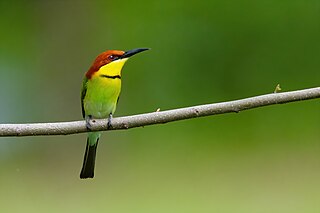
The chestnut-headed bee-eater, or bay-headed bee-eater, is a bird in the bee-eater family Meropidae. It breeds on the Indian subcontinent and adjoining regions, ranging from India east to Southeast Asia.

The white-throated bee-eater is a near passerine bird in the bee-eater family, Meropidae. It breeds in semi-desert along the southern edge of the Sahara, Africa. The white-throated bee-eater is migratory, wintering in a completely different habitat in the equatorial rain forests of Africa from southern Senegal to Uganda.

The blue-bearded bee-eater is a species of bee-eater found in much of the Indian subcontinent and parts of Southeast Asia. This bee-eater is found in forest clearings. It is found mainly in the Malayan region but extends west into peninsular India. The blue feathers of its throat are elongated and often fluffed giving it its name. They have a loud call but are not as gregarious or active as the smaller bee-eaters, and their square ended tail lacks the typical "wires" made up of the shafts of the longer central tail feathers found in many other bee-eaters.
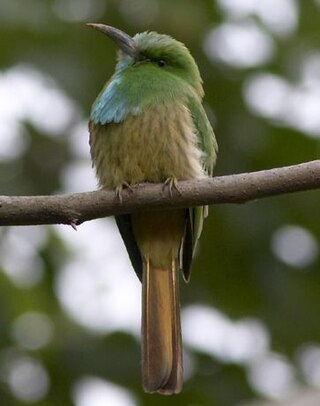
Nyctyornis is a genus of the bee-eaters, near passerine birds in the family Meropidae. There are just two members of this group, which occur in tropical south and southeastern Asia.

The northern carmine bee-eater is a brightly-coloured bird in the bee-eater family, Meropidae. It is found across northern tropical Africa, from Senegal eastwards to Somalia, Ethiopia and Kenya. It was formerly considered to be conspecific with the southern carmine bee-eater which has a carmine coloured throat rather than the blue throat of the northern species.
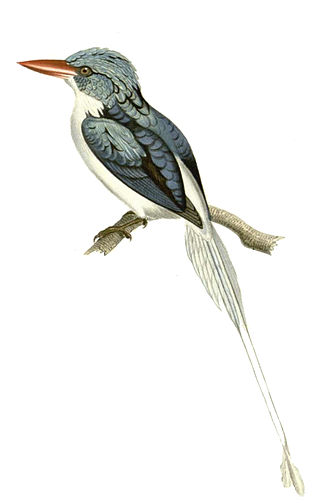
The Biak paradise kingfisher is a tree kingfisher that is endemic to the Indonesian island of Biak which is one of a small group of islands located in Cenderawasih Bay near the northern coast of Papua. This bird has a turquoise-blue back with a white belly and tail streamers and a reddish beak. Its natural habitat is forests and the IUCN has assessed its conservation status as being "near-threatened".

The lyre-tailed nightjar is a species of nightjar in the family Caprimulgidae. It is found in Argentina, Bolivia, Colombia, Ecuador, Peru, and Venezuela.

The purplish-backed quail-dove is a species of bird in the family Columbidae. It is found in Costa Rica and Panama.

The crested quail-dove is a species of bird in the family Columbidae. It is endemic to Jamaica.

The moustached kingfisher, also called Bougainville moustached kingfisher, is a species of bird in the family Alcedinidae. It is endemic to Bougainville Island in Papua New Guinea. An estimated 250–1,000 mature individuals are left.

The racket-tailed roller is a species of bird in the family Coraciidae. It is found in southern Africa from Angola, south-eastern Democratic Republic of Congo and southern Tanzania to northern Botswana, Zimbabwe, Malawi and Mozambique.
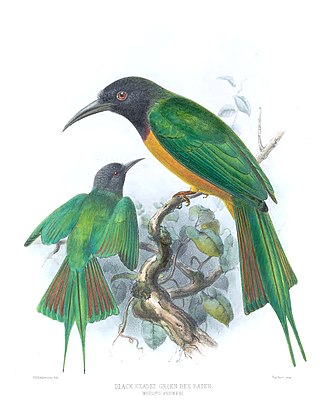
The black-headed bee-eater is a species of bird in the family Meropidae. It is found in forests in tropical Central and West Africa, its range including Angola, Central African Republic, Republic of the Congo, Democratic Republic of the Congo, Ivory Coast, Gabon, Ghana, Nigeria, and South Sudan.

The rosy bee-eater is a species of bird in the family Meropidae. It is found in Angola, Benin, Burkina Faso, Republic of the Congo, Democratic Republic of the Congo, Ivory Coast, Equatorial Guinea, Gabon, Ghana, Nigeria, and Togo.
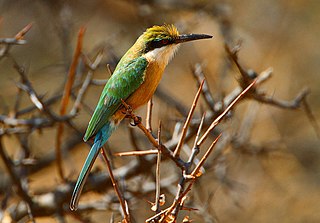
The Somali bee-eater is a species of bird in the family Meropidae. It is found in Ethiopia, Kenya, Saudi Arabia, Somalia and Tanzania. This is a small bee-eater that prefers arid country and desert areas where it may be locally common. The International Union for Conservation of Nature has assessed its conservation status as being of "least concern", postulating that clearing of woodland and forest is creating new suitable habitat for the bird and that its population trend may therefore be rising.
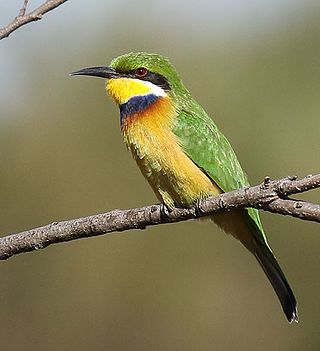
The blue-breasted bee-eater is a central African species of bird. It is a member of the family Meropidae. Meropids are all visually similar and have a diet specialized in Hymenopterans.

The blue-throated bee-eater is a species of bird in the bee-eater family. They are found throughout southeast Asia in subtropical or tropical mangrove forests. Their diet consists mostly of bees, wasps, and dragonflies. Blue-throated bee-eaters are small with colorful plumage consisting of a red nape, dark green wings, light green breast, and their signature blue throat. Juvenile plumage contain dark green head and wings and light green breasts, only developing their full plumage in adulthood. They have a rich variety of songs and calls, including longcalls which allow them to communicate long distances in the forest.

The black-capped paradise kingfisher or black-headed paradise kingfisher, is a bird in the tree kingfisher subfamily, Halcyoninae. It is native to several islands in the Bismarck Archipelago to the east of New Guinea. Like all paradise kingfishers, this bird has colourful plumage with a red bill and long distinctive tail streamers.





















